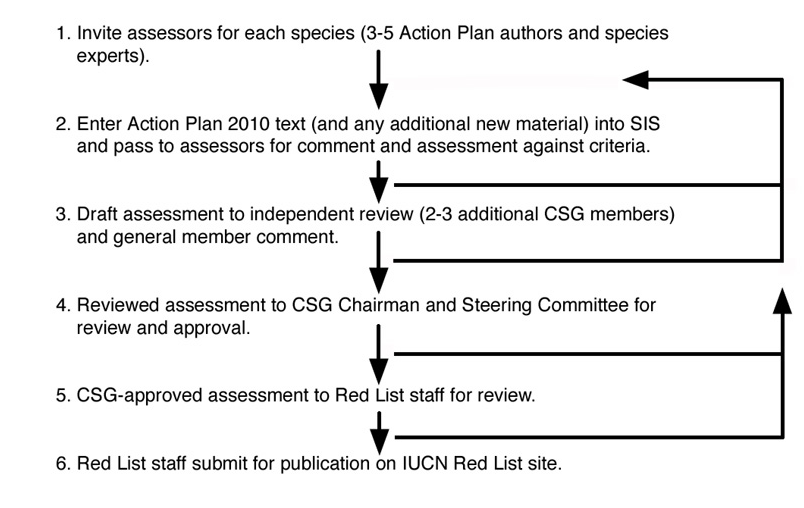CCBM1. INTRODUCTION 1.1. Background 1.2. Brief History of Crocodilian Conservation and Management 1.3. The IUCN Red List (Perran Ross) The IUCN Red List is the authoritative list of globally threatened animals and plants, now on-line, fully searchable and listing more than 35,000 animals. The Red List has always been generated by species experts of the Species Survival Commission (SSC) specialist groups - like the Crocodile Specialist Group (CSG). The CSG used new criteria to assign Red List categories to all 23 crocodilians in 2002 and has re-evaluated several species since then, notably the Gharial (Gavialis gangeticus), Cuban crocodile (Crocodylus rhombifer), Mugger (C. palustris), Tomistoma (Tomistoma schlegelii) and Philippine crocodile (C. mindorensis). However, most CSG crocodilian assessments are unchanged and largely unexamined since the mid-late 1990s and are overdue for updates. From early, fairly informal beginnings in 1972, the list and the process that produces it has steadily become more objective, scientific and (unavoidably) more complex. The current IUCN process and how CSG intends to assess crocodilians for Red Listing is described here. Red List categories and criteria are now based on IUCN Red List categories and criteria Version 3.1 (2001). Species are assigned to one of 7 categories if, and only if, they meet just one of the criteria applying to any category. Three of the categories are familiar 'threatened' status (Vulnerable, Endangered and Critically Endangered). The other categories accommodate species that are not threatened (Least Concern, Near Threatened, Extinct in the Wild, and Extinct). The criteria for threatened species cover 5 broad indices of extinction risk:
Each criterion has detailed components and sub-criteria and objective, quantitative thresholds. The terminology for Red List criteria is specific to this use and carefully defined. There are rules and Guidelines for applying the criteria and a large body of case history and precedent to guide their application. The Red List only considers all of a species throughout its global range, but there are additional criteria to adjust assessments of local or regional populations. All Red List assessments are now entered and processed through IUCN's Species Information System (SIS) - an automated on-line data base for Red List assessment. These components are all very fully described in the Red List materials and guidelines. To apply these criteria to a species, an 'assessment' is performed. This is usually done by specialist groups or by specially convened Global Biodiverisity Assessment Workshops. Assessments undergo a procedure of drafting, review and evaluation, checking by IUCN Red List staff, and then publication on a roughly annual schedule (assessments completed by August of one year are published by May of the following year). Each specialist group (including CSG) established a "Red List Authority"; (RLA) under the guidance of an RLA focal point to coordinate, review and submit its assessments. For the CSG, the final authority for Red Listing crocodiles lies with the CSG Chairman operating with the CSG Steering Committee. The Chairman has designated Dr. Perran Ross to be the CSG's RLA focal point and coordinate our internal process. In consultation with the Chair and Steering Committee, Dr. Ross proposes small groups of 'assessors' who generate the raw material of each species assessment. Each assessment is then independently reviewed by 2-3 experts additional to the assessors. The reviewed assessments will then be approved by the Chair and passed to SSC Red List staff. They will perform their own review - largely to ensure correct application and interpretation of the criteria - and upon approval, pass the assessment into the publication stream. In 2010 the CSG completed and published on-line 'Action Plans' for each crocodilian species, and these summarize the most current information, threats and situation review. These Action Plans were the basis for the next round of crocodilian Red List Assessments and their authors will be invited to be the core group of 'assessors' for each species. The contents of each species action plan can be transferred (largely cut and paste) into the required modules of SIS. With information and coaching from the RLA focal point, assessors can determine which, if any, of the criteria are supported by the available data and which threatened category, or none, applies. This draft assessment then needs to be externally reviewed by additional experts to confirm both the data and the application and interpretation of the Criteria. After review the draft will pass to the CSG Chair and Steering Committee for their review and approval before submitting to IUCN Red List staff. IUCN staff will review again and may request additional information or changes from the assessors and RLA before accepting the assessment for publication at the next available opportunity. We may also use CSG meetings or dedicated workshops as opportunity arises to use the assembled expertise of CSG members to conduct an assessment.
|

 Email CSG
Email CSG
